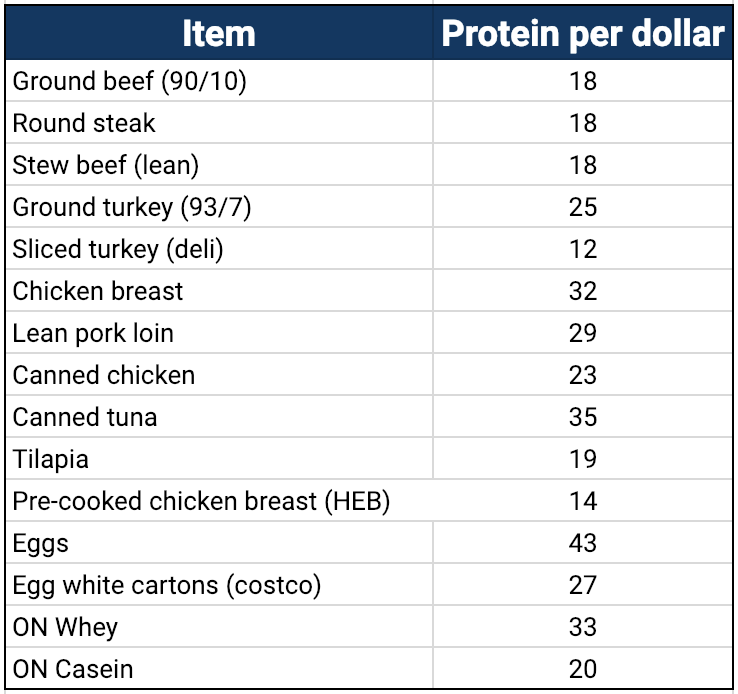There’s no question that food costs can add up, but eating healthy and sticking to your goals doesn’t have to break the bank.
If you usually buy processed food and alcohol or eat out regularly, you’ll break even or maybe even come out ahead on your monthly budget by switching to an RP diet.
Your grocery bill will probably increase, so you’ll feel like you’re spending more, but that will be offset by the healthier choices and habits you create.
Here are our favorite ways to stay budget-conscious while meal-prepping:
-
Don’t eat out. Meal prepping at home isn’t cheap, but buying the same food at a restaurant will cost you 3-4 times as much. The average American spends about $200-300 monthly on eating out. Stop worrying about saving $1 a pound on chicken and start saving hundreds a month by skipping out on restaurants and delivery.
-
Avoid food waste. Eat all the food you’re already buying! This seems obvious but think about how much food you’ve thrown away over the last few months. The average American throws away a whopping $1,300 worth of food every year. Revolutionary idea? No, but with some effort, this could make a massive difference in your grocery budget.
-
Eat the right amount of food. Remember, most food (especially meat and veggies!) weighs different amounts depending on whether it’s raw or cooked. Fortunately, the RP diet app can account for this, and you can easily switch from “cooked” or “raw” at the press of a button and keep those measurements accurate.
-
Clean out the pantry and freezer. You probably already have half-eaten bags of rice, oats, grits and three kinds of pasta (not to mention tons of cans of beans!) hanging out in your pantry. Quickly check everything you have piled up to eat “someday” and start eating through your stash.
-
Buy in-season fruit. Fruit can be part of a healthy and nutritious diet, but it is also one of the more expensive carb sources. The trick to getting fruit at the best possible price is only to buy in-season fruit, which costs less and often tastes better too!
-
Eat frozen veggies. Frozen veggies can be a cheap way to maximize your carbs, and nutritionally they are the same as fresh veggies. A massive bag of frozen veggies from your local grocery store will probably cost you around $1 a pound.
-
Shop at cheaper stores. Make sure you’re shopping at discount stores. Places like Costco, Walmart, and ALDI are cheaper than upper-scale grocery stores like Trader Joe’s and Whole Foods. Don’t be afraid of buying generic. You probably don’t need to buy “name brand” for everything—store brands work just fine.
-
Check the unit price for food. When you’re at the grocery store you don’t want to sit there with your calculator app trying to figure out which cut of meat or bag of rice is the most economical choice. Thankfully, you don’t have to! Every grocery store includes the unit cost on the price tag just below the item. The lower the unit price for food, the more food you get for your buck.
- Buy in bulk. Buying in bulk is one of the easiest ways to save money on groceries. Stores like Costco and Sam’s can be great for buying the food you need in bulk to get you a discount. Their prices aren’t always lower, so check that unit cost first.
The main downside is that you must have more money to save money since buying in bulk often costs more initially, and you’ll need space to store all that bulk food too.
- Meal plan based on what’s on sale. Most people plan their meals before they get to the store and then hope to get lucky by finding a store sale or a couple of good coupons. If you really want to take advantage of store sales and coupons, look up what’s on sale and plan your meals accordingly.
Selecting food sources
Some foods are much price than others. Choose wisely! Here are some charts to help you see the difference. They were created with pricing data from the US Department of Agriculture (USDA). Prices will likely vary region to region. If prices were not available, Amazon was used to give a reasonable estimate due to nationwide availability. Prices reflect bulk pricing.




Save even more money on food
If you haven't done much meal prepping in the past, check out the RP Cooking YouTube playlist full of diet-friendly recipes, many of which you can pull together from budget-friendly pantry staples. You can also get this jam-packed recipe value pack which includes all our published recipes.
Meal prepping can be daunting and make your diet experience even more stressful. Follow the tips above and you’ll stay on track with your diet and on budget!